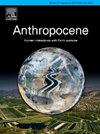Environmental DNA reveals anthropogenic impacts on fish diversity in mountain streams and the increasing risk of species invasion
IF 3.3
2区 地球科学
Q2 ENVIRONMENTAL SCIENCES
引用次数: 0
Abstract
Fish diversity and population dynamics are critical to freshwater ecosystem health. However, the direct disturbance of fish communities resulting from human activities and indirect impacts during environmental modifications pose significant risks to fish diversity. In this study, we employed eDNA metabarcoding technology to investigate the diversity and distribution of fish in the main water sources of the Zhejiang Jiulongshan National Nature Reserve. A total of 11 orders, 24 families, 47 genera and 61 species of fish, including 5 exotic species, were identified. The results revealed a greater number of fish species at the lower-elevation sampling sites but greater uncertainty at the higher-elevation sampling sites. However, small numbers of exotic fish species were observed at almost all the sampling sites. Cypriniformes served as biomarkers at the sampling sites with tourism activities, whereas more unique taxonomic units, such as Siluriformes and Gobiiformes, were observed at the sampling sites without tourism activities. Many environmental factors were significantly correlated with fish community differences within and outside the core area. Notably, the mean total organic carbon (TOC) and mean chemical oxygen demand (COD) levels were 8.73 % and 17.51 % greater, respectively, in the core area than outside the core area. In contrast, the phosphate, sulfide, Fe and pH levels were greater outside the core area than inside the core area. Our study revealed anthropogenic disturbances to biological communities in freshwater ecosystems by investigating the distribution and abundance of fish OTUs. Changes in the aquatic environment and biological invasions triggered by the activities of indigenous people, ecotourism and the operation of artificial fishponds may be the main risk factors influencing fish diversity in mountain streams.
环境DNA揭示了人类活动对山涧鱼类多样性的影响和物种入侵风险的增加
鱼类多样性和种群动态对淡水生态系统的健康至关重要。然而,人类活动对鱼类群落的直接干扰和环境变化过程中的间接影响对鱼类多样性构成了重大威胁。本研究采用eDNA元条形码技术对浙江九龙山国家级自然保护区主要水源鱼类的多样性和分布进行了研究。共鉴定出鱼类11目24科47属61种,其中外来种5种。结果表明,低海拔取样点的鱼类种类较多,而高海拔取样点的不确定性较大。然而,在几乎所有的采样点都观察到少量的外来鱼类。在有旅游活动的采样点以Cypriniformes为生物标记,而在没有旅游活动的采样点则以Siluriformes和Gobiiformes为独特的分类单位。许多环境因子与核心区内外鱼类群落差异呈显著相关。核心区的平均总有机碳(TOC)和平均化学需氧量(COD)水平分别比核心区外高8.73 %和17.51 %。相比之下,核心区外的磷酸盐、硫化物、铁和pH值高于核心区内。本研究通过调查鱼类otu的分布和丰度,揭示了淡水生态系统中生物群落的人为干扰。土著居民活动、生态旅游和人工鱼塘经营引发的水生环境变化和生物入侵可能是影响山间溪流鱼类多样性的主要危险因素。
本文章由计算机程序翻译,如有差异,请以英文原文为准。
求助全文
约1分钟内获得全文
求助全文
来源期刊

Anthropocene
Earth and Planetary Sciences-Earth and Planetary Sciences (miscellaneous)
CiteScore
6.30
自引率
0.00%
发文量
27
审稿时长
102 days
期刊介绍:
Anthropocene is an interdisciplinary journal that publishes peer-reviewed works addressing the nature, scale, and extent of interactions that people have with Earth processes and systems. The scope of the journal includes the significance of human activities in altering Earth’s landscapes, oceans, the atmosphere, cryosphere, and ecosystems over a range of time and space scales - from global phenomena over geologic eras to single isolated events - including the linkages, couplings, and feedbacks among physical, chemical, and biological components of Earth systems. The journal also addresses how such alterations can have profound effects on, and implications for, human society. As the scale and pace of human interactions with Earth systems have intensified in recent decades, understanding human-induced alterations in the past and present is critical to our ability to anticipate, mitigate, and adapt to changes in the future. The journal aims to provide a venue to focus research findings, discussions, and debates toward advancing predictive understanding of human interactions with Earth systems - one of the grand challenges of our time.
 求助内容:
求助内容: 应助结果提醒方式:
应助结果提醒方式:


